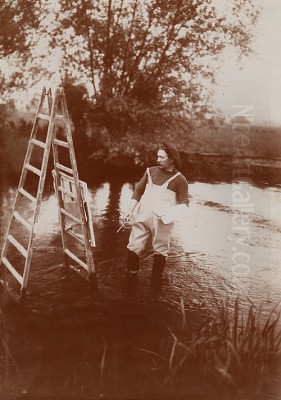
Louis Aston Knight stands as a significant figure in American art history, particularly noted for his luminous landscape paintings executed during a long and productive career spent primarily in France. Born into an artistic family and deeply influenced by the French Impressionist movement, Knight carved a unique niche for himself, capturing the idyllic beauty of the Normandy countryside with a distinctive blend of detailed realism and vibrant, light-filled brushwork. His work resonated strongly with audiences on both sides of the Atlantic, earning him numerous accolades and a lasting place in the annals of landscape painting.
Early Life and Artistic Foundations
Louis Aston Knight was born in Paris on August 3, 1873. His father was the renowned American expatriate artist Daniel Ridgway Knight, a painter celebrated for his detailed depictions of French peasant life set against picturesque landscapes. Growing up in this environment, the young Louis was immersed in art from his earliest years. His initial artistic training naturally came under the tutelage of his father, providing him with a solid grounding in academic technique and observation.
Beyond his father's instruction, Knight sought formal training to refine his skills. He studied at the prestigious Académie Julian in Paris, a crucible for many international artists during the late 19th and early 20th centuries. His mentors there included prominent figures of the French academic tradition: Tony Robert-Fleury, known for his historical compositions and portraits, and Jules Lefebvre, a master of the idealized female figure and a highly respected teacher. This formal education equipped Knight with the technical proficiency expected by the art establishment of the time.
His general education was not neglected; he attended Chigwell School in Essex, England, receiving a classical liberal arts education before fully committing to his artistic path. This combination of rigorous academic art training and a broader education provided a strong foundation for his future career, blending technical skill with a cultivated sensibility.
Launching a Career: The Paris Salon and Early Recognition
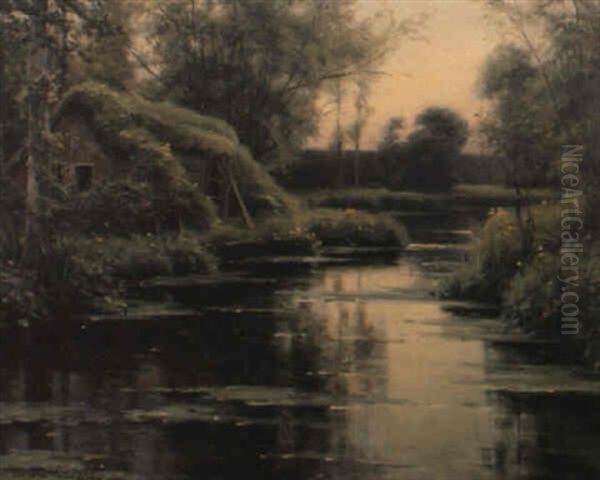
Knight made his public debut as an artist at the prestigious Paris Salon in 1894. The Salon was the official, state-sponsored exhibition in Paris and the primary venue for artists seeking recognition and patronage. To be accepted into the Salon was a significant achievement; to win awards there was a mark of considerable success. Knight's debut marked the beginning of a long and successful relationship with this institution.
His talent was quickly recognized. He began exhibiting regularly, and accolades followed. A significant early honor came at the Exposition Universelle (World's Fair) held in Paris in 1900, where he was awarded a Bronze Medal. This international exposure brought his work to a wider audience. The following year, in 1901, he received an Honorable Mention at the Paris Salon, further solidifying his reputation.
His rise continued steadily. He won a Gold Medal in Lyon in 1903, and achieved the coveted Third Class Gold Medal at the Paris Salon in 1905, followed by a Second Class Gold Medal in 1906. These awards were testament to his skill and the appeal of his chosen subject matter – the serene landscapes of Normandy. His success was not confined to France; his work also found favor in exhibitions in cities like Geneva and Reims.
Artistic Style: Impressionism Meets Realism
Louis Aston Knight's style is often categorized within the sphere of American Impressionism, yet it possesses unique characteristics that distinguish it. He deeply admired the work of the French Impressionists, particularly Claude Monet, whose revolutionary approach to light and color profoundly impacted the art world. Knight embraced the Impressionist emphasis on capturing the fleeting effects of natural light and atmosphere, often painting en plein air (outdoors) to directly observe his subjects.
However, Knight did not fully dissolve form in the manner of Monet or Camille Pissarro. While his brushwork could be loose and energetic, especially in rendering foliage and water, he retained a strong sense of structure and detail that perhaps owed something to his academic training and his father's more realistic style. His paintings often feature a meticulous rendering of architectural elements, such as the charming thatched-roof cottages near his home, and a careful delineation of trees and flowers.
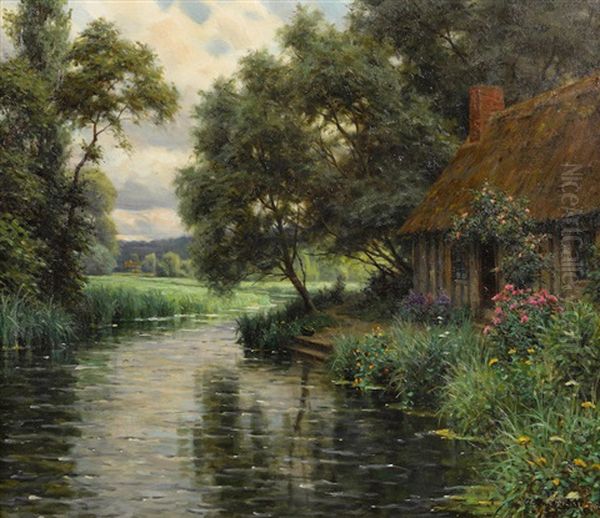
Water was a recurring and masterfully handled element in Knight's work. He was particularly adept at capturing the complex reflections and refractions on the surface of rivers and streams. His fascination with water led to a rather unique working method: he was known to don high rubber boots and set up his easel directly in the middle of a stream to achieve the precise perspective and water effects he desired. This practice earned him the affectionate nickname "the painter in high rubber boots," reportedly coined by the American writer and engineer F. Hopkinson Smith, who championed his work early on.
His palette was typically bright and optimistic, filled with the greens of lush foliage, the blues of clear skies and water, and the vibrant hues of blooming flowers. He favored scenes of tranquil beauty – sun-dappled rivers, well-tended gardens, picturesque cottages bathed in gentle light. Unlike some Impressionists who depicted modern urban life or the wilder aspects of nature, Knight focused almost exclusively on the serene, cultivated landscapes of rural Normandy.
The Influence of Monet and Giverny
The connection between Louis Aston Knight and Claude Monet was significant. Knight was a frequent visitor to Monet's famous home and garden in Giverny, located not far from his own residence in Normandy. He deeply admired Monet's dedication to capturing the nuances of light and atmosphere, and particularly Monet's passion for his garden, which served as a living, breathing subject for countless masterpieces.
Inspired by Monet, Knight developed his own magnificent garden at his home in Beaumont-le-Roger. This garden became a primary source of inspiration and subject matter for his paintings. He sought to emulate the beauty and artistic potential that Monet had cultivated at Giverny. While Knight's style remained distinct from Monet's later, more abstract water lily series, the influence is evident in Knight's focus on floral abundance, reflective water surfaces, and the interplay of light across his cultivated landscapes.
This connection places Knight firmly within the orbit of Impressionism, not just stylistically but also through personal association with its leading figure. His work can be seen as continuing the Impressionist tradition of landscape painting, albeit with his own particular blend of detail and atmospheric effect, perhaps closer in spirit to the earlier work of Monet or Alfred Sisley than to the later, more radical developments of Impressionism.
Father and Son: A Shared Passion, Distinct Paths
The relationship between Louis Aston Knight and his father, Daniel Ridgway Knight, is an interesting aspect of his career. Both were successful American expatriate artists painting French landscapes, which could have led to direct comparison and competition. However, sources suggest they reached an understanding to maintain distinct artistic identities.
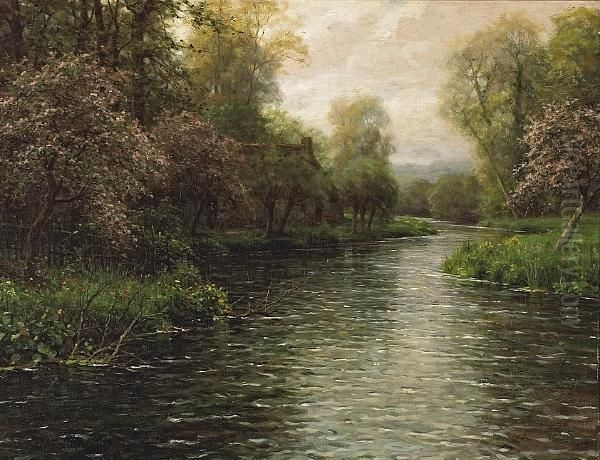
Daniel Ridgway Knight focused primarily on figurative scenes, often depicting peasant women engaged in daily tasks within carefully rendered landscape settings. His style was generally tighter, more detailed, and aligned with a form of academic realism popular in the late 19th century, sometimes compared to the work of artists like Jules Breton or even echoing the meticulousness of Jean-Léon Gérôme in landscape detail.
Louis Aston Knight, while inheriting a love for the French countryside and a commitment to skillful execution, moved decisively towards landscape as his primary subject. His embrace of Impressionist techniques, particularly the focus on light and atmosphere and the looser brushwork in passages, set his work apart from his father's more narrative and figurative focus. While both painted idyllic visions of rural France, the son's work felt more modern and directly engaged with the innovations of Impressionism. This differentiation allowed both artists to thrive without directly overshadowing one another.
Life and Work in Beaumont-le-Roger
After achieving success, Knight established his home and studio in Beaumont-le-Roger, a picturesque town in Normandy situated on the Risle river. His house, reportedly named "Chantereine," became central to his life and art. It was here that he cultivated his extensive garden, inspired by Monet's Giverny, which featured prominently in many of his paintings.
His connection to the local landscape was profound. He painted the Risle river repeatedly, capturing its moods in different seasons and times of day. The charming cottages of the region, with their distinctive thatched roofs and flower-filled yards, became signature motifs in his work. He developed a strong relationship with the local community. An interesting anecdote reveals his dedication to finding perfect subjects: he reportedly offered annual prizes to his neighbors for the best-kept gardens, ensuring a steady supply of beautiful, paintable scenes right outside his doorstep.
This deep immersion in his chosen environment allowed him to paint with authenticity and affection. His works are not mere topographical records; they convey a sense of peace, stability, and the enduring charm of rural French life, an idealized vision that appealed greatly to collectors, particularly Americans seeking nostalgic or romanticized views of Europe. His approach contrasts with the Barbizon School painters like Jean-Baptiste-Camille Corot or Jean-François Millet, who often depicted a more rugged or labor-focused view of the countryside decades earlier.
Notable Works and Enduring Themes
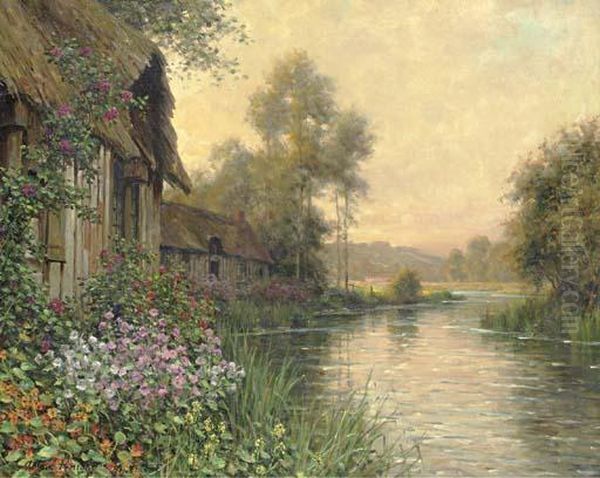
Among Louis Aston Knight's most famous works is The Afterglow. This painting gained particular prominence when it was purchased by the President of the United States. Sources confirm President Warren G. Harding acquired the painting in 1922 for the White House collection, where it hung as a symbol of American appreciation for refined European landscape art. The title itself suggests a typical Knight theme: the beautiful, transient effects of light on the landscape at the end of the day.
Another representative work is The Risle Valley in Normandy, showcasing his beloved local river winding through a lush, sunlit landscape. Many of his paintings bear titles that reflect his primary subjects: Diane's Pool, The Brook, Cottage by the River, Summer Evening, In the Garden at Beaumont-le-Roger. These titles underscore his consistent focus on water, gardens, cottages, and the interplay of light within these serene settings.
His paintings consistently celebrate a harmonious vision of nature, often improved and ordered by human presence through gardens and quaint architecture. There's a sense of cleanliness and tidiness; nature is beautiful but not wild or threatening. This idealized portrayal resonated with the tastes of the Gilded Age and early 20th-century collectors who sought beauty, tranquility, and technical skill in art.
Recognition, Reputation, and Transatlantic Appeal
Louis Aston Knight achieved significant recognition during his lifetime. Beyond his numerous Salon medals, he was made a Chevalier of the Légion d'Honneur in 1920, France's highest order of merit, and was later promoted to Officer in 1927, and Commander in 1934. These honors indicate the high esteem in which he was held in his adopted country.
His reputation extended strongly to the United States. He exhibited regularly in major American cities like New York, and his works were eagerly acquired by American collectors and museums. The purchase of The Afterglow for the White House was a major endorsement. His success mirrored that of other prominent American expatriate artists who found fame abroad while retaining strong ties to their homeland, such as John Singer Sargent, James McNeill Whistler, and Mary Cassatt, although Knight's focus remained more consistently on landscape than these contemporaries.
His work offered a comforting and beautiful vision that contrasted with the more challenging and avant-garde movements emerging in the early 20th century, such as Fauvism or Cubism. Knight remained committed to his established style, refining his depictions of Normandy's beauty throughout his career. His popularity suggests a continuing public appetite for well-executed, aesthetically pleasing landscape painting grounded in Impressionist principles but retaining representational clarity.
Later Years and Lasting Legacy
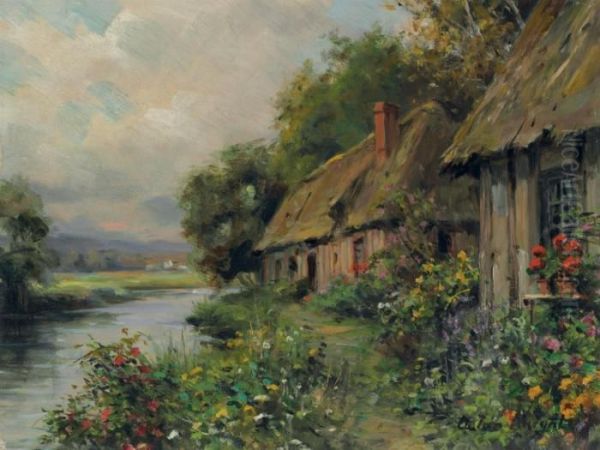
Louis Aston Knight continued to paint prolifically throughout his life, remaining based in France. He maintained his focus on the landscapes he knew and loved, consistently producing works characterized by their luminous quality and meticulous attention to the beauty of the natural world, particularly the interplay of light and water. He passed away in New York City on May 8, 1948, while visiting the United States.
His legacy lies in his contribution to the tradition of American Impressionist landscape painting. He successfully synthesized French Impressionist influences with his own detailed approach, creating a distinctive and highly popular style. His works captured an idealized vision of rural Normandy that continues to appeal to viewers seeking beauty and tranquility.
Today, Louis Aston Knight's paintings are held in numerous museum collections, including the Musée d'Orsay in Paris (works formerly in the Musée du Luxembourg), the Toledo Museum of Art, the Brooklyn Museum, the National Gallery of Art in Washington D.C., and many other institutions in the United States and Europe. His enduring popularity is also evident in the art market, where his works continue to be sought after by collectors. He stands as a testament to the success an American artist could achieve abroad, mastering European techniques while creating a body of work that resonated deeply with audiences on both continents. His paintings remain cherished examples of landscape art from the turn of the 20th century, celebrating light, water, and the enduring charm of the French countryside, seen through an American expatriate's appreciative eyes, much like Childe Hassam captured the light of New England or the Isles of Shoals.
Conclusion: A Master of Light and Landscape
Louis Aston Knight occupies a unique position in art history as an American expatriate who became one of the foremost interpreters of the Normandy landscape. Deeply influenced by Impressionism, particularly his interactions with Claude Monet, he developed a style that combined vibrant light and color with a satisfying degree of realism and detail. His dedication to painting en plein air, his mastery of depicting water, and his focus on the idyllic beauty of gardens and riverscapes defined his oeuvre. Honored in France and highly popular in the United States, Knight built a successful career creating works that offered tranquility and aesthetic pleasure. His paintings remain a beloved part of the landscape tradition, capturing a specific, idealized vision of rural France with enduring skill and charm.